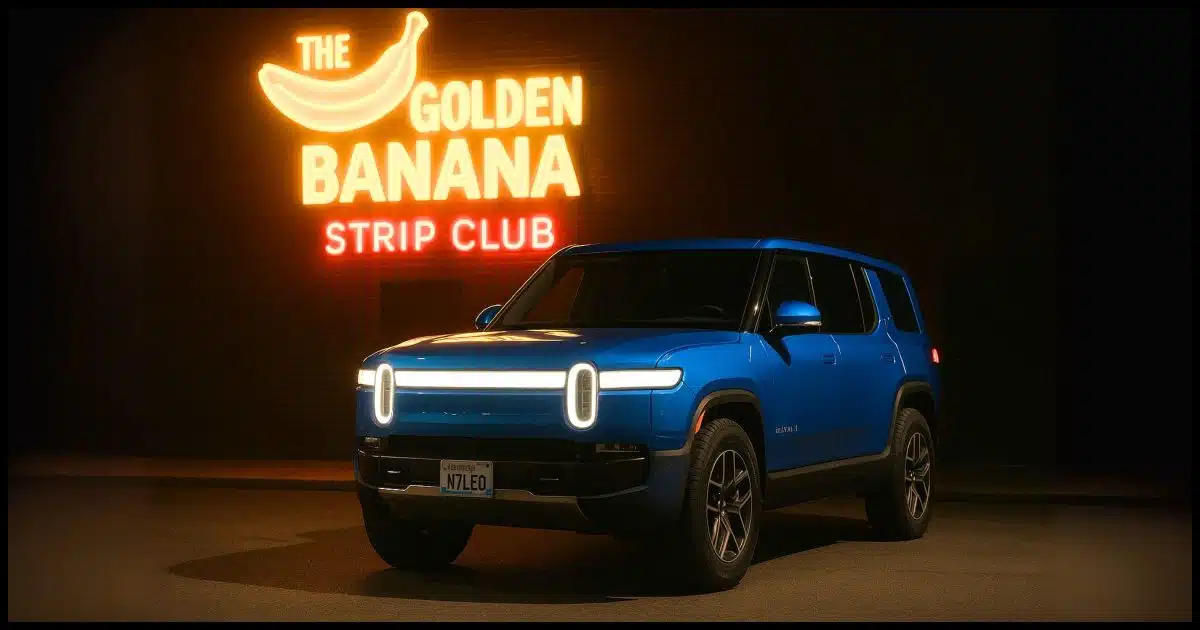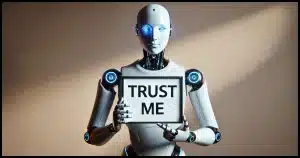New tools mean new threats.

The image above is not my car.
It looks like my car. The color is close, the model is correct, and the license plate is mine.1 But I’ve never parked outside The Golden Banana strip club. I have no idea if such a strip club even exists.
That the AI-generated photo looks so real, however, is cause for concern. Deep concern.

Fake photos to scam you
AI can create fake photos that look real, and scammers are ready to use this to trick you. If an image shows something shocking or too perfect, think twice. It might be a fake made to fool you — perhaps even specifically you. You can’t believe everything you see. Always be skeptical.
Son of Photoshop
I think we’ve all come to be slightly suspicious of photos because of the rise of Adobe Photoshop and similar tools. In the hands of the right person, Photoshop can generate amazing things, ranging from altering existing photos to creating “photos” of things and situations that never happened. With talent and time, a Photoshop artist can create just about anything.
Emphasis, of course, on both talent and time.
AI removes both of those requirements. The image above was created by asking ChatGPT:
Please create a 16:9 photorealistic image of a blue 2025 Rivian R1S, Washington license plate “N7LEO” parked in front of “The Golden Banana” strip club at night.
Two minutes later, the image above appeared. It’s plausible enough to pass for real to the casual observer.
Scammers know this.
Help keep it going by becoming a Patron.
Example scam
A scam posted on Reddit’s r/Scams subredit brought this to my attention.
The original poster (or “OP”) asked how the scammer was able to identify his license plate to use in the photo. It turns out that an assortment of information, ranging from vehicle type and characteristics to the name of the owner, is often available. It might be publicly available through shady services, or it might be illegally available to hackers knowing where to look (perhaps on the dark web).
But looking up a license plate associated with a specific person is apparently not that hard for those so criminally inclined.
And as we’ve seen, using that information to craft a fake yet plausible image to use in an extortion scam takes all of a couple of minutes.
It’s about more than your car or your license plate
Using your car’s information to create a realistic photo to attempt to scam you is only an example. Scammers don’t have to extort you personally; perhaps they use fake images to sway public opinion. There’s a range of uses:
- Photos in extortion attempts, no matter how realistic you think they look, are often AI-generated fakes. Scammers can use data discovered in breaches and elsewhere to create highly targeted scams, including bespoke images related to the targets of their scams.
- Photos on social media of someone doing something you’d never expect them to do are frequently AI-generated fakes.
- Sadly, photos from just about any organization with an agenda — political, social, or otherwise — are now often complete AI-generated constructions (or existing photos altered using AI) to reflect something that never really took place.
It’s now trivial for anyone to create images that look real and are completely fake. Scammers, hucksters, and others with less than altruistic intentions are more than happy to use this new technology to fool us.
And fool us, they do, especially if the fake image is of something we want to see or confirms our preconceived ideas.
How to avoid getting fooled
It all boils down to paying attention, and that’s very difficult in today’s fast-paced, attention-grabbing world.
For example, consider the photo above. There are signs it’s fake. The most obvious is that the shadows are wrong: there should be a shadow to the right of the car caused by the bright strip club sign. A close look at the license plate shows it’s “fuzzier”, for lack of a better term, than the quality of the photo would imply it should be.
Of course, if you can compare it to reality, it becomes even more obvious: the vehicle color is off, and my roof rack is missing.
Yes, those all seem like small, even subtle clues, but they’re easy to overlook, and scammers are counting on you to do exactly that. And yet they’re exactly the kinds of things you should look for the moment there’s any question at all.
And these days there should probably always be a question.
Do this
Be skeptical. I can’t emphasize this strongly enough. You must question everything, even — perhaps especially — if it appears to support what you already believe.
When the scammers come calling, know that they have used information found in breaches and elsewhere to make their scams as legitimate-looking as possible. Don’t be fooled.
Especially if you’ve never been to a strip club. (Or at least, not that strip club.)
Subscribe to Confident Computing! Less frustration and more confidence, solutions, answers, and tips in your inbox every week.



73 N7LEO de K2GBH !
I have probably been on your site for years. I appreciate the information that you put out. It would be nice if there was a program to check for fakes. I’m sure someone will come up with something.
Hello, to all Americans. I’ve been around , a long time. Todays’ Greed, is the ‘ synthetic oil ‘ fuelling ALL Corporate Companies. Ai is following, along. EACH HUMAN BEING, must of NECESSITY ; 1) Simplify Your Life, by: NOT going ‘ out to lunch ‘ or ‘ to bars ‘ or to strip clubs. THERE IS ABSOLUTELY nothing, WORTH YOUR WHILE…at these places. Short, fleeting moments, of ‘ pleasure ‘ ? Does not Take it with you. Look at our history, the last 120 years. Everyone, pleasure /entertainment seeking ; and as Colbert used to comment …..” meanwhile ” the country is going ‘ down the drain ‘ as Steppenwolf said, in a 1970 song, Monster. 2) Come OUT OF THIS world, of GREED. IF your NOT a ‘ part ‘ of it ; then NO ONE knows you ! Stay at home – go for a nature walk. SWITCH OFF your GOD…..you all know what that is, eh ? Smart phones since 07 with Mr Jobs, and what do we have ? STUPID people, total LOSS of ‘ common sense ‘ NATURAL LOGIC….which grandpa and gramma had IN ABUNDANCE…. and Very Impatient, spoiled, emotionally immature, unstable PEOPLE. Most totally useless, with their HANDS…./ Spoiled, at 40 years of age, and Younger. LOOK at USA courts systems. Insanity reigns supreme. Get Back To Biblical Laws – leave this world , of deception and GREED. // Anyway, thanks, Uncle Leo, for all You Do and ARE. Continue managing, as best you can, and all that is, within Your Power. !
Another sign that the image is fake . . . it’s too perfect. Blemishes such as smudges have been removed.
Right. That car is way cleaner than most real cars being driven by real people. Probably cleaner than Leo’s car really is.
I think one of the best ways to find out if the image is fake is to ask Chat GBT to analyze the photo. Turn the technology back on itself.
Leo, you wrote:
“…the shadows are wrong: there should be a shadow to the right of the car caused by the bright strip club sign…
That’s your only observation with the shadows?!? (Not very attentive, are you?)
How about that the shadow is on the wrong side of the truck!?! The shadow lies to the left of the truck, between the truck and the sign — precisely where it shouldn’t be!!!
It seems there’s a very strong street light to the right of the picture which wipes out the strip club’s shadow and shows the car’s shadow in the right place. No light reflecting on the car’s body surface as it uses special non reflective paint.
(Don’t take this seriously, well someone might)
That shadow could be explained by a light off to the right.
BTW, Leo — “written by a real human”?
Just the sort of thing any self-respecting AI would say…
Unfortunately, you’re right, but Leo really writes his own articles.
There is a Golden Banana strip club – sign over the door says “DB’s Golden Banana” in Peabody, Massachusetts. Leo, I hope you didn’t drive there and back in the same day!
I’ll be going to the North Shore next month, but I don’t plan to go to the Golden Banana. Does it look like Leo’s AI generated image?
Leo, are you aware that when you supplied a link to “my” roof rack, you exposed hundreds of your Flickr photos?
Leo’s Flicker is a public profile.
If course. It’s a public profile. Come for the roof rack, stay for the Corgis.
When I clicked that link to check it out, I stayed for a while to look at the Corgi pix. 🙂
Nothing wrong seeing a clean vehicle in the picture, my vehicles always look that clean, even if they are well over ten years old. I’m the guy that parks his vehicle in the far end of the parking lot where nobody else parks…